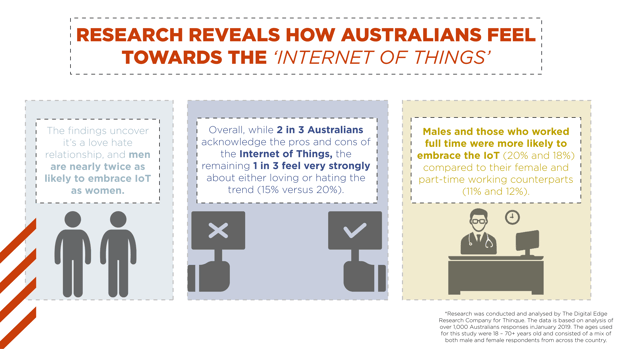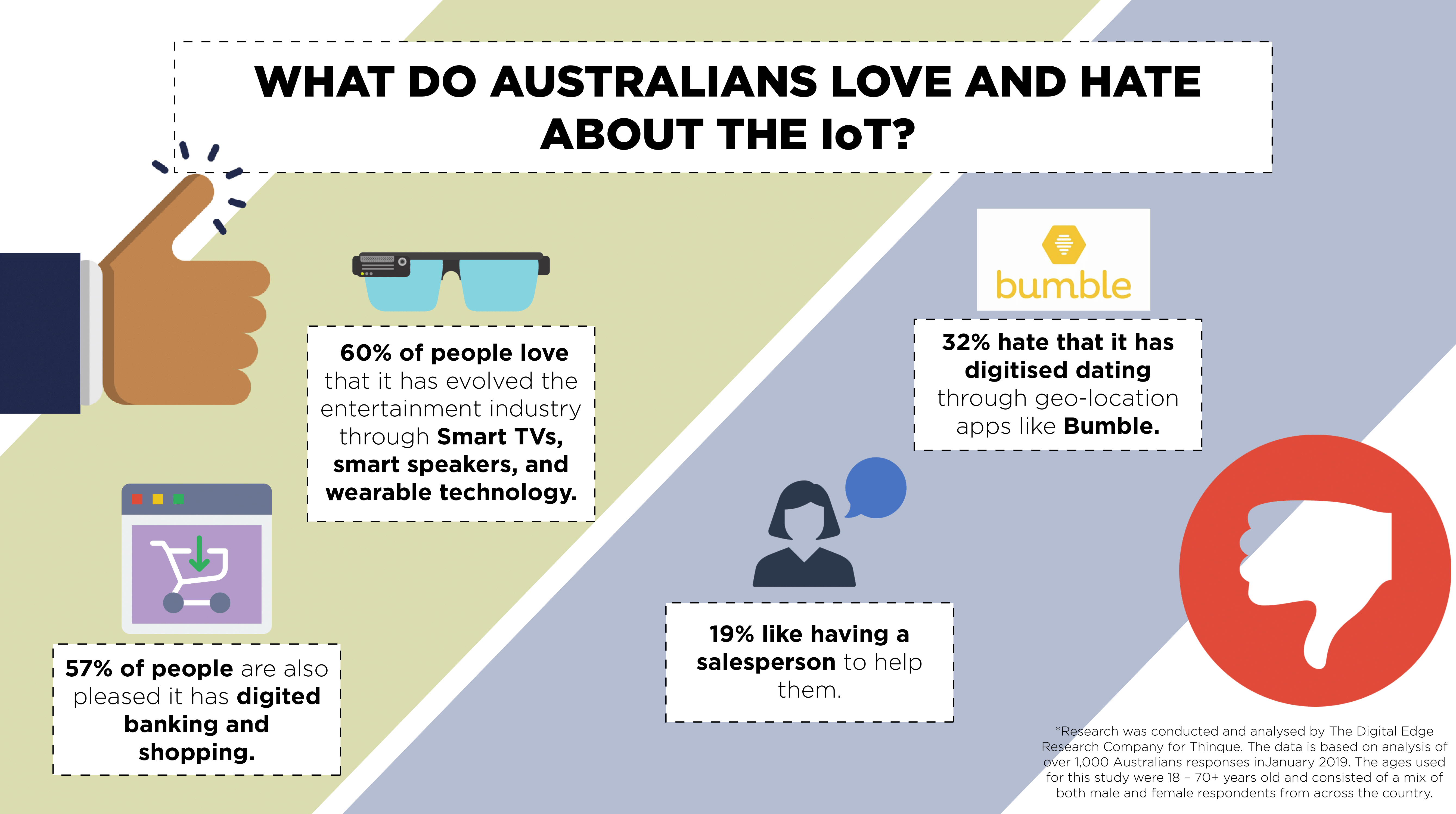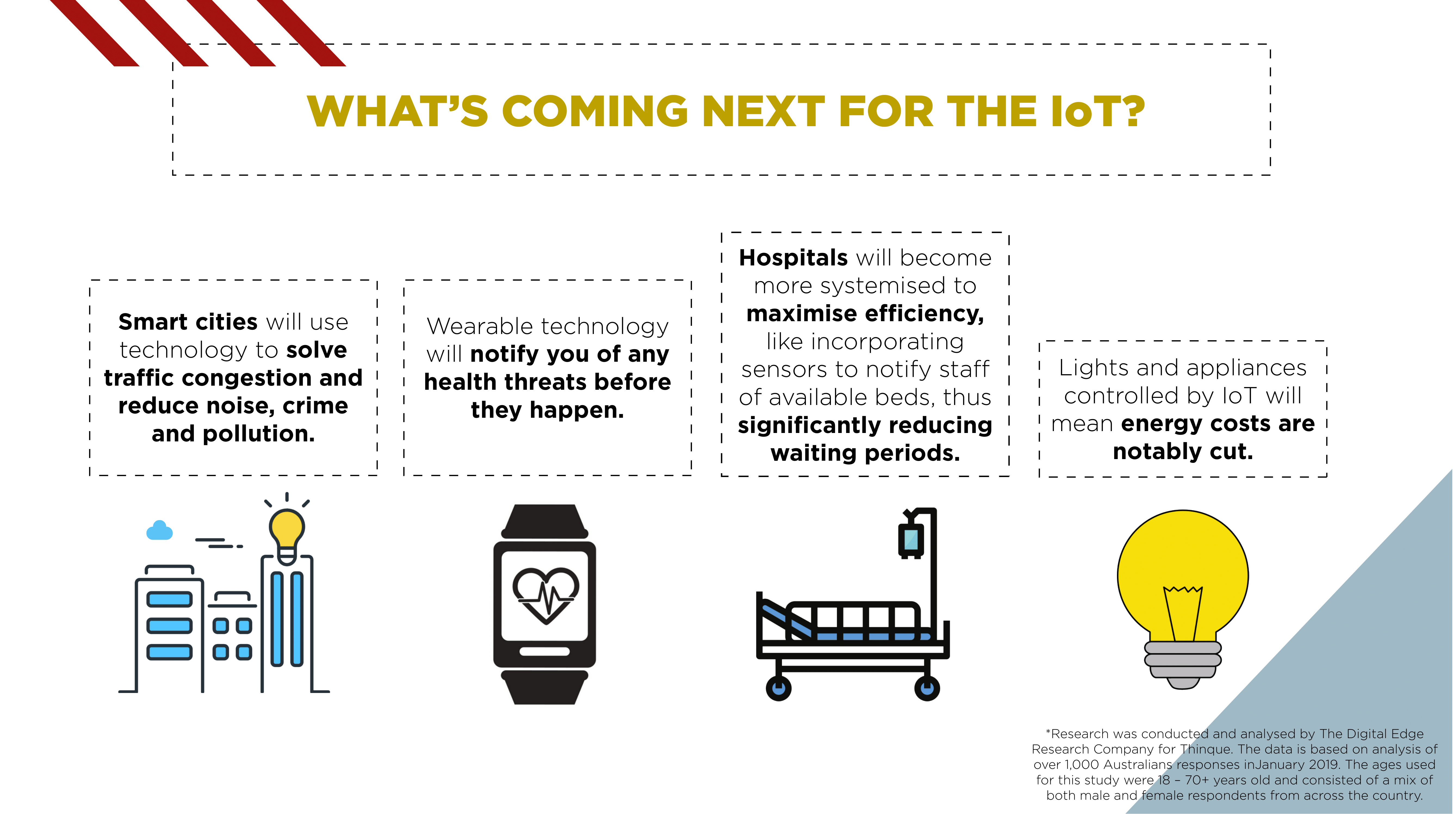Foresights and ideas that expand minds and inspire a change of heart.

The Internet of Things (IoT) has allowed devices to connect, interact, and exchange data so that we can do exponentially more than we used to in the old analogue world. The moment your IoT alarm goes off at 6 in the morning, your coffee machine begins brewing your drink so that by the time you’re in the kitchen (after one hit of the snooze button), your steaming espresso is ready to stimulate your brain.
As IoT becomes ever more enmeshed in our day-to-day lives, we’re starting to experience a more seamless cyber-physical environment (the 4th industrial Revolution is truly here!) - whether we are on the road, in our smart homes, or in a “Factory of the Future”.
Because of the growing demand, the industry is expected to generate between $4T and $11T in economic value in 2025.[1] While IoT continues to be integrated into our day to day activities, our foresearch from the think tank - Thinque - reveals that the Australian population has mixed feelings about the rise of intelligent machines.
Research findings show that while 2 in 3 Australians are aware of what IoT is, the remainder exhibits strong (and divisive) opinions either against or for the trend. 15% of the aforementioned respondents support having and using IoT, while the 20% are ardent dissenters.
Looking closer at the geo-data, Western Australian locals embrace IoT with 1 in 5 saying they love it and feel it could do more for them. In Queensland, 1 in 4 “hate” IoT and don’t want it to exist. Males and full-time workers are more likely to support IoT (20% and 18%) than females and part-time workers (11% and 12%).

Futurist Anders Sörman-Nilsson analyses the data by concluding that there is still a great divide among Australians on the Internet of Things, especially how this emergent technology has digitised particular industries. Australian locals are pleased that the retail (60%), banking (57%), and entertainment (57%) sectors now use IoT to engage with their customers better. However, 32% of locals express their distaste for digitising social experiences like dating and making friends. 25% say the same for Government services and 45% of survey respondents say that they miss human interaction as their key reason for being against complete digitisation courtesy of IoT.
As we step into a more digitised world day after day, here is what we can reasonably expect from the Internet of Things when it comes to humanising our planet:

Traffic is expected to lessen. Smart cities, including Adelaide, are using IoT to solve traffic congestion and reduce noise, crime and pollution.
By creating specialised algorithms to study data from traffic light networks and monthly traffic volume, computers can make real-time decisions and lessen waiting times.
Healthcare will improve. Family, caregivers and patients (who need constant monitoring from wearable technology) will be notified immediately when an irregularity appears onscreen. Details like low blood pressure, hormonal changes, gait or illness symptoms can be assessed before it’s too late.
This helps hospitals become more efficient with treatment and emergency response situations. In the future, all hospital beds will be equipped with sensors to notify staff of available beds and significantly reduce waiting periods.
Energy-saving will become a trend. Smart homes will cut energy costs to a minimum by switching lights and appliances off when they are not in use. Thermostats for the home heater and fridge will also self-adjust to ensure the output is kept to a minimum until necessary.
As digitisation both disrupts and moves our everyday activities into Tomorrowland, brands need to foster a sense of community with their customers. In the world of a modern consumer, people need true connections that keep them from isolation and help them transition seamlessly into a technological world. Ultimately, in today’s society, IoT technology is another avenue for brands to reach the analogue hearts and digital minds of their customers.
In order to connect with the customers of tomorrow, learn how to amplify your brand signal through future storytelling. Check out Anders Sörman-Nilsson’s webinar on the Future of Branding today.
[1] https://techjury.net/stats-about/internet-of-things-statistics/

Header Text
Lorem ipsum dolor sit amet, consectetur adipiscing elit, sed do eiusmod tempor incididunt ut labore et dolore magna aliqua. Ut enim ad minim veniam, quis nostrud exercitation ullamco laboris nisi ut aliquip ex ea commodo consequat. Duis aute irure dolor in reprehenderit in voluptate velit esse cillum dolore eu fugiat nulla pariatur.
Lorem ipsum dolor sit amet, consectetur adipiscing elit, sed do eiusmod tempor incididunt ut labore et dolore magna aliqua. Ut enim ad minim veniam, quis nostrud exercitation ullamco laboris nisi ut aliquip ex ea commodo consequat. Duis aute irure dolor in reprehenderit in voluptate velit esse cillum dolore eu fugiat nulla pariatur.
Lorem ipsum dolor sit amet, consectetur adipiscing elit, sed do eiusmod tempor incididunt ut labore et dolore magna aliqua. Ut enim ad minim veniam, quis nostrud exercitation ullamco laboris nisi ut aliquip ex ea commodo consequat. Duis aute irure dolor in reprehenderit in voluptate velit esse cillum dolore eu fugiat nulla pariatur.

Header Text
Lorem ipsum dolor sit amet, consectetur adipiscing elit, sed do eiusmod tempor incididunt ut labore et dolore magna aliqua. Ut enim ad minim veniam, quis nostrud exercitation ullamco laboris nisi ut aliquip ex ea commodo consequat. Duis aute irure dolor in reprehenderit in voluptate velit esse cillum dolore eu fugiat nulla pariatur.
Lorem ipsum dolor sit amet, consectetur adipiscing elit, sed do eiusmod tempor incididunt ut labore et dolore magna aliqua. Ut enim ad minim veniam, quis nostrud exercitation ullamco laboris nisi ut aliquip ex ea commodo consequat. Duis aute irure dolor in reprehenderit in voluptate velit esse cillum dolore eu fugiat nulla pariatur.
Lorem ipsum dolor sit amet, consectetur adipiscing elit, sed do eiusmod tempor incididunt ut labore et dolore magna aliqua. Ut enim ad minim veniam, quis nostrud exercitation ullamco laboris nisi ut aliquip ex ea commodo consequat. Duis aute irure dolor in reprehenderit in voluptate velit esse cillum dolore eu fugiat nulla pariatur.

Header Text
Lorem ipsum dolor sit amet, consectetur adipiscing elit, sed do eiusmod tempor incididunt ut labore et dolore magna aliqua. Ut enim ad minim veniam, quis nostrud exercitation ullamco laboris nisi ut aliquip ex ea commodo consequat. Duis aute irure dolor in reprehenderit in voluptate velit esse cillum dolore eu fugiat nulla pariatur.
Lorem ipsum dolor sit amet, consectetur adipiscing elit, sed do eiusmod tempor incididunt ut labore et dolore magna aliqua. Ut enim ad minim veniam, quis nostrud exercitation ullamco laboris nisi ut aliquip ex ea commodo consequat. Duis aute irure dolor in reprehenderit in voluptate velit esse cillum dolore eu fugiat nulla pariatur.
Lorem ipsum dolor sit amet, consectetur adipiscing elit, sed do eiusmod tempor incididunt ut labore et dolore magna aliqua. Ut enim ad minim veniam, quis nostrud exercitation ullamco laboris nisi ut aliquip ex ea commodo consequat. Duis aute irure dolor in reprehenderit in voluptate velit esse cillum dolore eu fugiat nulla pariatur.
& STAY UP TO DATE WITH FORESIGHTS AND TREND REPORTS!
WE WILL EQUIP YOU WITH THE VIDEOS AND MATERIALS YOU NEED TO SUCCESSFULLY PITCH ASN.
0 Comment